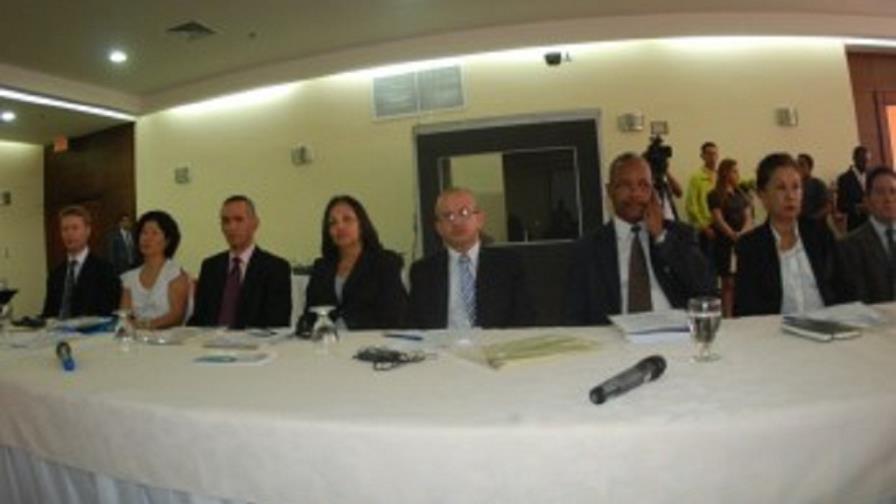Two billion dollars for Haiti to fight Cholera

SANTO DOMINGO. The organizations of international cooperation tied to the health area will donate to the Haitian authorities US$2.0 billion and to the Dominican Republic US$70 million to fight the cholera epidemic on the island.
This was reported yesterday by the representative of the Central Office of the Pan American Health Organization (PAHO) in Washington, Kate Dilson, who said that in the Haitian case the resources will be granted over 10 or 15 years, while for this country it will be over five years.
Dilson said that the resources are part of the Bi-National Cholera Plan and that in Haiti they will prioritize the issue related to water and that the time span will be longer because the area is more vulnerable.
The cholera epidemic that left 7,000 dead according to official statistics has been kept down to about six cases a week on average, which the authorities attribute to the educational measures that they developed in that country.
Since the beginning of the epidemic at the end of 2010, in Haiti there were days in which up to 200 deaths were registered.
This was confirmed by the director of regional Health Services of Haiti, Donal Francois, who sahd that the reduction also is due to the priority given to other areas which are considered to be fundamental, among which are water and health, watchfulness and promoting new habits in the population.
Also a rapid attention to those who are sick enables them to save lives.
These initiatives are picked up again in the bi-national plan and will be part of the bi-national agreement and of the project called Elimination of Cholera on the Island of Hispaniola which will be signed today by the ministers of Heath from Haiti, Dr. Florence Guillaume, and the Dominican Republic, Dr. Freddy Hidalgo Nuñez.
Before the signing, since yesterday the representatives of the PAHO, the Center for Control of Diseases and the United Nations Children's Fund (UNICEF), began a meeting of bi-national coordination with the objective of exchanging information and laying out plans for fighting the disease and put an end to it in 2022.
At the same time, in the country up until now there have been 26,000 cases, including the latest outbreak in Tamboril and more than 350 deaths.
The death rate from cholera in Haiti was recognized recently by the World Health Organization which said that they have made important progress in comparison with other African countries.
Francois recognizes the support that they receive from the Dominican authorities.
"We have always worked with the Dominican Republic, and not just with cholera and the diseases, there is a very tight cooperation between the two countries and on both sides of the frontier we believe that this has been understood as such and we are in the best position to strengthen these relations," Francois noted.
For his part, the Minister of Public Health, Freddy Hidalgo Nuñez, praised the meeting, where he saw a vision of what the two countries are doing to fight the epidemic, what the achievements were and the next steps to be taken to keep the diarrhea causing illness out of the island.
Tomorrow (today) they will come to a conclusion as to where they are going to continue focusing the work, taking into account that everything indicates that what has been done up to now is positive.
Invitation
On another order of business, the director of regional Health Services in Haiti delivered a letter of invitation to the Minister of Public Health, Freddy Hidalgo Nuñez, for an event that will take place in Haiti this month which is being sponsored by the First Lady of that nation.
He said that they will deal with a particular issue that will interest both nations and the national community which is the elimination of the vertical transmission of the HIV virus.
This was reported yesterday by the representative of the Central Office of the Pan American Health Organization (PAHO) in Washington, Kate Dilson, who said that in the Haitian case the resources will be granted over 10 or 15 years, while for this country it will be over five years.
Dilson said that the resources are part of the Bi-National Cholera Plan and that in Haiti they will prioritize the issue related to water and that the time span will be longer because the area is more vulnerable.
The cholera epidemic that left 7,000 dead according to official statistics has been kept down to about six cases a week on average, which the authorities attribute to the educational measures that they developed in that country.
Since the beginning of the epidemic at the end of 2010, in Haiti there were days in which up to 200 deaths were registered.
This was confirmed by the director of regional Health Services of Haiti, Donal Francois, who sahd that the reduction also is due to the priority given to other areas which are considered to be fundamental, among which are water and health, watchfulness and promoting new habits in the population.
Also a rapid attention to those who are sick enables them to save lives.
These initiatives are picked up again in the bi-national plan and will be part of the bi-national agreement and of the project called Elimination of Cholera on the Island of Hispaniola which will be signed today by the ministers of Heath from Haiti, Dr. Florence Guillaume, and the Dominican Republic, Dr. Freddy Hidalgo Nuñez.
Before the signing, since yesterday the representatives of the PAHO, the Center for Control of Diseases and the United Nations Children's Fund (UNICEF), began a meeting of bi-national coordination with the objective of exchanging information and laying out plans for fighting the disease and put an end to it in 2022.
At the same time, in the country up until now there have been 26,000 cases, including the latest outbreak in Tamboril and more than 350 deaths.
The death rate from cholera in Haiti was recognized recently by the World Health Organization which said that they have made important progress in comparison with other African countries.
Francois recognizes the support that they receive from the Dominican authorities.
"We have always worked with the Dominican Republic, and not just with cholera and the diseases, there is a very tight cooperation between the two countries and on both sides of the frontier we believe that this has been understood as such and we are in the best position to strengthen these relations," Francois noted.
For his part, the Minister of Public Health, Freddy Hidalgo Nuñez, praised the meeting, where he saw a vision of what the two countries are doing to fight the epidemic, what the achievements were and the next steps to be taken to keep the diarrhea causing illness out of the island.
Tomorrow (today) they will come to a conclusion as to where they are going to continue focusing the work, taking into account that everything indicates that what has been done up to now is positive.
Invitation
On another order of business, the director of regional Health Services in Haiti delivered a letter of invitation to the Minister of Public Health, Freddy Hidalgo Nuñez, for an event that will take place in Haiti this month which is being sponsored by the First Lady of that nation.
He said that they will deal with a particular issue that will interest both nations and the national community which is the elimination of the vertical transmission of the HIV virus.

 Diario Libre
Diario Libre
 Diario Libre
Diario Libre